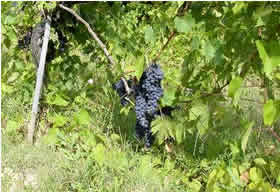Il Chianti

Visiting Tuscany means appreciating the Chianti red wine produced in numerous areas of the region and representing one of the recognized symbols of Tuscany. In effect, even though it is identified with the area included between Florence and Siena, the Chianti wine is also produced in Arezzo, Pistoia, Prato and Pisa with different origin names.
This is a kind of ruby-coloured wine becoming slightly garnet-red coloured with aging.
Its smell is quite winy with violet shadings. Its flavour is harmonious, dry and it has a slightly soft velvety taste with time. It particularly suits roast red meat and game and it could not have been otherwise, given the hunting tradition of this territory.
The introduction of vines in the Chianti territory is traditionally ascribed to the Etruscans, one of the first populations in the Italian peninsula to nourish frequent exchanges with the Greeks.
In the XIII century, some documents started to report on the "Chianti League", constituted in Florence in the ambit of the relations kept with some villages that today make part of the Chianti Classico producing area.
At that time, these villages were already trading a red wine with a base of Sangiovese wine. The emblem of the League was a black rooster that is still today the emblem of the existing "Consorzio del Chianti Classico".
The first form of legal protection of the Chianti was the announcement by Cosimo de' Medici in 1716 defining the area where the Chianti production had to be carried out and the creation of a Vigilance Congregation with the duty to control the production, the trade and the protection of the Tuscan wines.
Nevertheless, until the XVIII century, the Chianti wine was produced exclusively with the Sangiovese grapes.
It was only from the XIX century that a range of blends started to be studied to make its flavour more peculiar.
In 1840, the Baron Ricasoli gave to know the composition of the Chianti that is still respected today: 70% Sangiovese grapes, 15% Canaiolo grapes and 15% Malvasia grapes.
Today, the exportation of precious wines is the main resource of the Chianti economy, around which a thick network of wine trade and food-and-wine tourism has developed.
Currently, beyond Italy, the Chianti wine is particularly requested in the United States, that has been the main importer for some years now, but it is also exported in Germany and the United Kingdom.
The Vin Santo of the Chianti Classico is particularly appreciated, too. It is a dessert, amber-coloured wine existing in both dry and sweet versions.
In the wake of the Chianti's success, also the Chianti oil has recently obtained the Protected Origin Denomination and the "poor" cuisine of the Chianti area with salt meats and typical kinds of cheese have started to catch the interest of good food lovers.